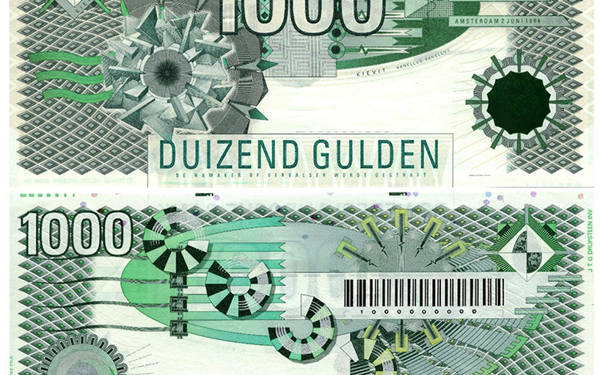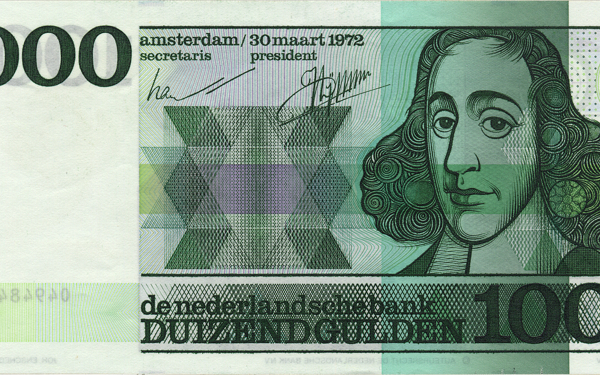Lapwing f 1000 (1994)
The Lapwing thousand guilder banknote is one of four notes created by graphic designer Jaap Drupsteen. People had to search for the bird on the note.
Read more Lapwing f 1000 (1994)You are using an outdated browser. DNB.nl works best with:

© DNB
Buzz… buzz… buzz! Did you know that banknotes can make noise? By scratching your fingernail over the orange (intaglio) line pattern on the reverse of this f 50 Sunflower banknote, you can hear the sound of a buzzing bee! But is it really a bee? In 1982, De Volkskrant newspaper received a letter from a concerned reader: “To my dismay, people keep talking about a bee on the fifty note, but… it’s a wasp!”

© DNB
That bee (or wasp) was much discussed anyway. Oxenaar had drawn the little critter on a separate piece of paper which he stuck on the design (see the magnifying glass on the image). Oxenaar probably did so because he only figured out later that this would be a nice addition. The bee’s three-dimensional effect is enhanced by the letters next to the flower: the Sunflower is in fact the very first note featuring a vertical lettering position. Buzz… buzz… oh yes - the bee! On his way to the bank’s board, Oxenaar's ‘bee sticker’ fell off the design! According to the story, he stuck it back on provisionally with a bit of spit. That must have been a nerve-racking moment! In hindsight, everything was fine, as the Board was very pleased.
At first, the f 50 note was not a common denomination at all. The last f 50 note had been withdrawn from circulation in 1960 because Dutch people weren’t interested in it. But things were different in the early 1980s. Inflation was increasing and by 1977, as much as 60 per cent of banknote circulation consisted of f 100 notes. Public surveys clearly showed the need for a denomination between f 25 and f 100. That meant Oxenaar had to get back to work.
In the seven-part Nature series – which also includes the Lighthouse and Snipe models – there was still room for one colour: yellow. The orange-yellow sunflower, which subtly referenced Van Gogh’s painting of sunflowers, and the bee were chosen by Oxenaar, accompanied by a map of the IJsselmeer polders. The note was a perfect fit for DNB’s Nature series, which featured images that were recognisable to all. DNB introduced the note with a comprehensive public leaflet explaining the note and its features, including authenticity features.
The Sunflower has been described – together with the Lighthouse and the Snipe – as one of the highlights of Dutch money history. A poll in 1985 found that young people in particular thought the Sunflower was the nicest note. Even during the introduction of the euro banknotes, people looked back with nostalgia, and in 2006, the Sunflower was even voted the second most beautiful Dutch object ever (the Fokker F27 Friendship aircraft came in first place).
Until 1 January 2032, this note can still be redeemed at our Cash Desk
Curious to find out more?

The Lapwing thousand guilder banknote is one of four notes created by graphic designer Jaap Drupsteen. People had to search for the bird on the note.
Read more Lapwing f 1000 (1994)
A classic portrait from Dutch history, with a contemporary twist. This ten-guilder note shows the face of Frans Hals, one of the most famous Dutch painters of the 17th century.
Read more The Frans Hals f 10 model (1968)
Whenever new guilder designs were created, DNB was always closely involved. Regardless of the denomination, the bank kept a close eye on the designer’s work. After all, the authenticity features were of great importance and as such required great precision. The story of this banknote is about... fingers!
Read more The Spinoza f 1000 model (1972)
‘Cheerfulness, respectability and dignity’, that’s what the new f 250 note from designer R.D.E. (‘Ootje’) Oxenaar was intended to exude. The lighthouse, which was inspired by the one at Haamstede in Zeeland, was a recognisable and identifiable Dutch symbol that perfectly met these DNB requirements.
Read more The Lighthouse f 250 model (1986)We use cookies to optimise the user-friendliness of our website.
Read more about the cookies we use and the data they collect in our cookie notice.